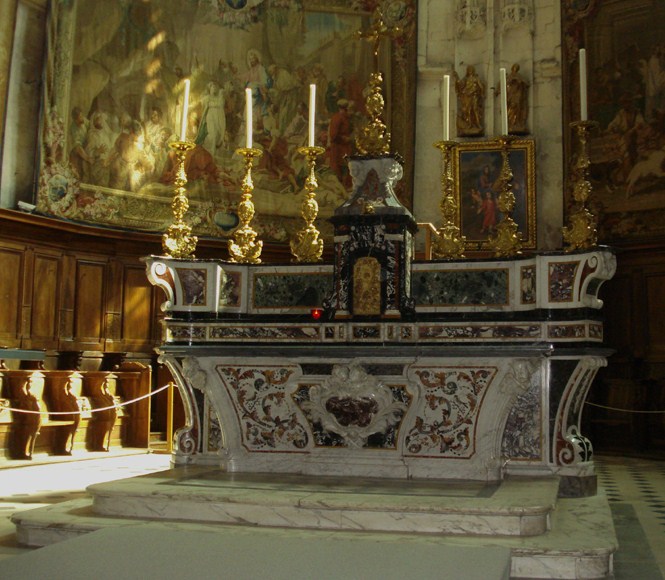Over in France they seem to have a particular knack for liturgy and liturgical art.
The Cathedral of Saint Vincent in Viviers down in the South has a beautiful 18th century marble high altar. It doesn't look as if it has suffered at all from the corrosive liturgical fashions of the past fifty or years or so.
But those with an attachment to the modern forms of the liturgy need not fear. A 'facing the people' altar is in front of it. In fact, a new one has recently been put in place. It is called the "contemporary altar".
Wow! It's...really quite something, isn't it? And this is for a cathedral!
Readers are welcome to share their thoughts. Once again the Pimpernel is at a bit of a loss as to what to say about this latest liturgical creation coming out of France, "catastrophically creative"? "ignoble simplicity"? "tragically out of place?" Perhaps "an essay in discontinuity in wood and glass" sums it up best?
Maybe somebody should translate Benedict XVI and Beauty in Sacred Art and Architecture into French and send the Bishop of Viviers a copy? His diocese dates from the fourth century. What might his predecessors think? More importantly, as His Excellency soon turns 71, what will his successor think?



I am going to be positive. If you had to put in an altar "versus populum" this is certainly a good choice. It will be easy to remove once certain French liturgists and bishops get their sanity back.
ReplyDeleteDas ist ja unglaublich!
ReplyDelete--William
I've always loved how the singular precept of Vatican II that seems to escape all of these "Spirit of Vatican II" priests and bishops is the prohibition of having multiple altars in the sanctuary. (Though technically I suppose the structures that are being placed in the sanctuaries are only altars in a strictly academic sense: a flat surface on which a consecration takes place.) And thankfully, the governments of western European countries prohibit the destruction of the old altars.
ReplyDeleteLord, save your Church from her clergy!
Well, I know what happened. This was ordered for a log cabin church in Northern Minnesota and got delivered to the cathedral instead. It must be odd to have a marble and brass Baroque altar in that logcabin.
ReplyDeleteHow utterly inappropriate! Who is their interior decorator? OI!
The Rev..Michael P. Forbes, Minnesota
French churches have been doing stunts like this since long before Vatican II. They aren't alone by a long shot. Not only is this altar in contrast to the baroque high altar, it is intended to be an insult to it.
ReplyDeleteIf you have to have a second altar in the sanctuary, at least have one in harmony with the church interior and the original altar. This example of the altar obviously intended for mass "ad versus populum", smacks of , "let's make a cultural statement, and a statement about me".
Enough of such statements and attacks on our religious sensitivities in order to draw our attention to the whims and agendas set by the designer. I'd love to see what he/she has in mind for the baptismal font. Let me guess. A clear plastic tub with the steps molded into the inside wall?
Fortunately the standards are higher in some other French cathedrals like at Strasbourg and Chartres.
ReplyDeleteIn smaller South German churches most 'People's Altars' (as they are called in German, 'Volksaltar') installed in the 1970s are light wooden constructions that mimic the (in many cases Baroque) High Altar.
ReplyDeleteHowever, in the last years there is a tendence to install contraptions out of stone, steel and perspex that are are permanent structures and ofen lead to some damage of the Sanctuary Floor.
I fear that the now slowly retiring generation of clergy want to leave their mark for the coming generations.
It is unfortunately not true that the Law in most European countries protects historical works of art in Churches - in Bavaria the goverment has to be consulted but cannot veto any changes necessary for liturgical reasons (whoever defines them), and in Baden-Württemberg the dioceses can do whatever they want. A few years ago two 15th-century altars in Freiburg Cathedral were destroyed with pickaxes in order not to give more room to the steps surrounding the new red granite cube placed between them.
Viviers is not alone in its abominably bad taste. The Church of St. Nicholas in Amsterdam, which a couple years ago was elevated to the status of co-cathedral of the diocese Haarlem-Amsterdam, contains a very similar-looking contemporary table-altar - really, just a standing log with a small square of thick transparent plastic resting upon it - in front of the real, historical Altar. The ceremony of renaming the diocese 'Haarlem-Amsterdam' (formerly 'Haarlem') was proclaimed by the Bishop Ordinarius and the Papal Nuntius at the table; they then celebrated Vespers at this insignifcant and ugly table, incensing the table as seriously as they could, which made them and the whole ceremony seem even more ridiculous. So, dear Pimpernel, not only the French have abandoned their dignified Altar of Christ in order to serve the tiny plastic table of Baal, but so have the Dutch (and many others, including the Italians: tiny plastic tables with an artificial plant on one side and a fat, short candle or two on the other, can been seen in many an italian church nowadays).
ReplyDeleteSo that's where that carpet I threw out got to
ReplyDeleteI see they've used a cigarette packet under one corner to level it!
ReplyDeleteAh...the bane of all sane/traditional/orthodox Catholics...the "people's altar", ironing board, picnic table, butcher block, mortuary slab, Cramner table...it goes by so many names. The most hideous of the V-II spirit effects. I don't WANT to worship people...I get enough of that all week...I just want to be left alone to worship GOD on Sunday. I want to live long enough to see the Punch-n-Judy tables REMOVED from our Catholic sanctuaries.
ReplyDelete-John A.